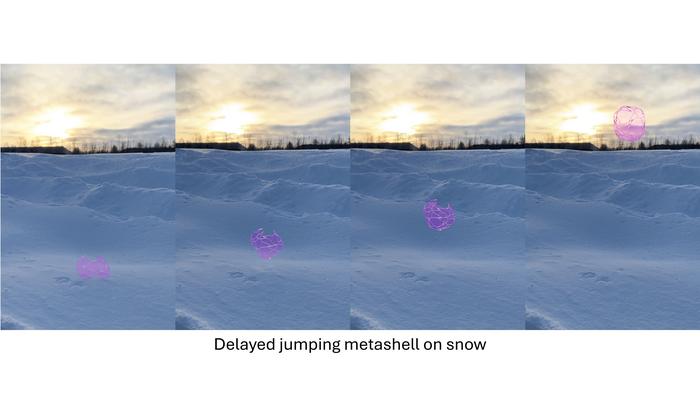Researchers at North Carolina State University have made groundbreaking advancements in material science, creating dynamic structures known as "metashells" that can leap into the air on a predetermined schedule. This innovative development marks a significant milestone, as these metashells are capable of executing jumps without relying on any external stimuli or real-time computing interventions. The timing and height of each jump are intricately engineered into the structure itself, showcasing the remarkable possibilities of programmable materials.
The fundamentals of these metashells lie in their unique design—spherical shapes created from strands of polyethylene terephthalate (PET) arranged in a complex lattice pattern. This configuration maximizes the material’s inherent capacity to store energy. When weight is applied to the metashell, it deforms, storing potential energy within its structure. Unlike conventional materials that immediately snap back, PET exhibits viscoelastic properties, leading to a slow initial return to its original shape. Following this initial phase, once a critical deformation threshold is reached, the materials undergo a sudden and pivotal transition, restoring their original form rapidly, which results in the spectacular jump.
The research, led by Jie Yin, an associate professor of mechanical engineering, articulates a dual purpose: effectively controlling the jump’s timing while enhancing the dynamics of the mechanical structure. The jump mechanism is meticulously constructed so that the length of time for which the load is applied directly correlates with the timing of the jump. Specifically, if the load remains for an extended duration, the structure will release its potential energy later, resulting in a delayed and potentially lower jump. This novel approach not only reignites interest in materials science but also paves the way for applications in various fields, from robotics to environmental science.
A pivotal element of the research is the visualization of these metashells in action. Image documentation reveals snapshots of a metashell leaping off a snowy surface, demonstrating its versatility across different terrains. During testing, the researchers were able to angle jumps from as brief as three seconds to as long as 58 hours in advance, highlighting the remarkable precision that can be achieved through engineering and material design. The metashells’ jump heights ranged dramatically, allowing them to reach up to nine times their height or a mere half of it, depending on how far in advance the jump was pre-programmed.
The implications of this research extend beyond mere curiosity. By successfully demonstrating that these structures can launch from varied surfaces—from solid ground to sand, snow, and even water—the researchers have opened avenues for practical applications. For instance, the metashells can be employed for purposes ranging from environmental monitoring to precision agriculture. One influential application demonstrated the capacity for the metashells to carry and disperse cargo, such as seeds. This mimics natural processes akin to explosive seed dispersal seen in plants like Impatiens balsamina, which enables the scattering of seeds over significant distances, enriching biodiversity in various ecosystems.
The research also emphasizes the importance of material properties in determining the performance of such programmable structures. The viscoelastic nature of PET combined with intelligent design allows these metashells not only to perform but excel in multifaceted environments, enhancing their functionality and application scope. With the potential to innovate this technology, researchers are keen to explore the use of biodegradable materials that align with the sustainable goals in engineering and apply their findings to the practical world.
Furthermore, this work is underpinned by robust funding from the National Science Foundation, showcasing the value of collaborative research and the transformative potential of new material technologies. Researchers Yang and Yin have filed for a patent related to their invention, signaling robust commercial prospects and innovation pathways for enterprises interested in embedding this technology into their operations.
In communicating these advancements, the researchers advocate for future collaborations. By engaging with both academia and the private sector, they envision expanding the scope and applications of their work, which holds promise for ecological applications, consumer products, and beyond. As the fields of material science and engineering continue to evolve, such collaborations will likely accelerate the translation of research into real-world applications, further amplifying the impact of their discoveries.
The comprehensive nature of this study underscores the intricate relationship between design, material properties, and engineering principles. It sets a precedent for future research, propelling exploration in programmable materials and smart polymers that can be tailored to meet specific operational needs. As the technology progresses, it may well find uses in entirely new domains, expanding the horizons of engineering and innovation.
In conclusion, with their ability to jump on command, the engineered metashells symbolize a new frontier in material science—bridging the gap between theoretical research and practical application. As momentum builds around this technology, the anticipation for its next phases and potential impacts continues to grow, underscoring the role of innovative engineering in shaping our future.
Subject of Research: Metashells with programmable jumping capabilities
Article Title: Programmable seconds-to-days long delayed snapping in jumping metashell
News Publication Date: 2-Jun-2025
Web References: NC State Study
References: Proceedings of the National Academy of Sciences
Image Credits: Haitao Qing, NC State University
Keywords
Metashells, Programmable Materials, Mechanical Engineering, Energy Storage, Seed Dispersal, Viscoelasticity, Polyethylene Terephthalate, Dynamic Structures, Material Science, Innovation.




